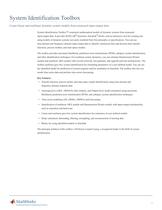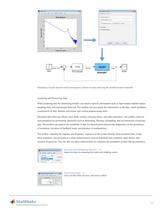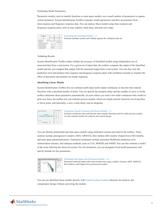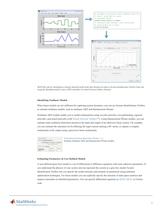
Excertos do catálogo

System Identification Toolbox Create linear and nonlinear dynamic system models from measured input-output data System Identification Toolbox™ constructs mathematical models of dynamic systems from measured input-output data. It provides MATLAB® functions, Simulink® blocks, and an interactive tool for creating and using models of dynamic systems not easily modeled from first principles or specifications. You can use time-domain and frequency-domain input-output data to identify continuous-time and discrete-time transfer functions, process models, and state-space models. The toolbox provides maximum likelihood, prediction-error minimization (PEM), subspace system identification, and other identification techniques. For nonlinear system dynamics, you can estimate Hammerstein-Weiner models and nonlinear ARX models with wavelet network, tree-partition, and sigmoid network nonlinearities. The toolbox performs grey-box system identification for estimating parameters of a user-defined model. You can use the identified model for prediction of system response and for simulation in Simulink. The toolbox also lets you model time-series data and perform time-series forecasting. Key Features ▪ Transfer function, process model, and state-space model identification using time-domain and frequency-domain response data ▪ Autoregressive (ARX, ARMAX), Box-Jenkins, and Output-Error model estimation using maximum likelihood, prediction-error minimization (PEM), and subspace system identification techniques ▪ Time-series modeling (AR, ARMA, ARIMA) and forecasting ▪ Identification of nonlinear ARX models and Hammerstein-Weiner models with input-output nonlinearities such as saturation and dead zone ▪ Linear and nonlinear grey-box system identification for estimation of user-defined models ▪ Delay estimation, detrending, filtering, resampling, and reconstruction of missing data ▪ Blocks for using identified models in Simulink The principal architect of the toolbox is Professor Lennart Ljung, a recognized leader in the field of system identification.
Abrir o catálogo na página 1
W System Identification Tool - Model Estimation Using System Identification Toolbox (top) to import, analyze, andpreprocess data (left), estimate linear and nonlinear models (bottom), and validate estimated models (right). Identifying Models from Data System Identification Toolbox lets you create models from measured input-output data. You can: ■ Analyze and process data ■ Determine suitable model structure and order, and estimate model parameters ■ Validate model accuracy Introduction to System Identification Toolbox 2:28 Get started with System Identification Toolbox. You can use...
Abrir o catálogo na página 2
Identifying a transfer function model from frequency-domain test data and using the identified model in Simulink. Analyzing and Processing Data When preparing data for identifying models, you need to specify information such as input-output channel names, sampling time, and intersample behavior. The toolbox lets you attach this information to the data, which facilitates visualization of data, domain conversion, and various preprocessing tasks. Measured data often has offsets, slow drifts, outliers, missing values, and other anomalies. The toolbox removes such anomalies by performing...
Abrir o catálogo na página 3
Estimating Model Parameters Parametric models, such as transfer functions or state-space models, use a small number of parameters to capture system dynamics. System Identification Toolbox estimates model parameters and their uncertainties from time-response and frequency-response data. You can analyze these models using time-response and frequency-response plots, such as step, impulse, bode plots, and pole-zero maps. Estimating and Validating Models 1:21 Estimate multiple models and validate against the validation data set. Validating Results System Identification Toolbox helps validate the...
Abrir o catálogo na página 4
MATLAB code for identifying a transfer function model from time-domain test data in System Identification Toolbox (top) and using the identified model to tune a PID controller in Control System Toolbox (bottom). Identifying Nonlinear Models When linear models are not sufficient for capturing system dynamics, you can use System Identification Toolbox to estimate nonlinear models, such as nonlinear ARX and Hammerstein-Wiener. Nonlinear ARX models enable you to model nonlinearities using wavelet networks, tree-partitioning, sigmoid networks, and neural networks (with Neural Network Toolbox™)....
Abrir o catálogo na página 5
Modeling Time-Series Data A time series is one or more measured output channels with no measured input. System Identification Toolbox lets you create time-series data models to forecast future signal values based on previous ones. You can estimate time-series models using both time-domain and frequency-domain data. You can estimate time-series spectra that describe time-series variations using cyclic components at different frequencies. You can also estimate parametric autoregressive (AR), autoregressive and moving average (ARMA), autoregressive integrated moving average (ARIMA), and...
Abrir o catálogo na página 6Todos os catálogos e folhetos técnicos The MathWorks
-
MATLAB Production Server
6 Páginas
-
Database Toolbox
4 Páginas
-
MATLAB Report Generator
4 Páginas
-
Stateflow
8 Páginas
-
SimEvents
7 Páginas
-
SimDriveline
7 Páginas
-
SimHydraulics
7 Páginas
-
SimPowerSystems
8 Páginas
-
Simulink Control Design
5 Páginas
-
Aerospace Blockset
5 Páginas
-
Communications System Toolbox
9 Páginas
-
SimRF
6 Páginas
-
Simulink Coder
6 Páginas
-
Embedded Coder
8 Páginas
-
Simulink PLC Coder
4 Páginas
-
Fixed-Point Designer
9 Páginas
-
MATLAB Coder
5 Páginas
-
Simulink 3D Animation
10 Páginas
-
Gauges Blockset
2 Páginas
-
Simulink Report Generator
3 Páginas
-
Polyspace Bug Finder
6 Páginas
-
global-optimization-toolbox
10 Páginas
-
Phased Array System Toolbox
9 Páginas
-
OPC Toolbox
5 Páginas
-
Simulink Design Verifier
7 Páginas
-
Simulink Design Optimization
10 Páginas
-
Filter Design HDL Coder
5 Páginas
-
Bioinformatics Toolbox
9 Páginas
-
SimBiology
6 Páginas
-
Computer Vision System Toolbox
10 Páginas
-
DSP System Toolbox
11 Páginas
-
Fuzzy Logic Toolbox
5 Páginas
-
Polyspace Client for C/C++
5 Páginas
-
xPC Target
5 Páginas
-
SimMechanics
7 Páginas
-
Simscape
7 Páginas
-
Simulink
6 Páginas
-
Data Acquisition Toolbox
8 Páginas
-
Image Processing Toolbox
7 Páginas
-
Signal Processing Toolbox
10 Páginas
-
Control System Toolbox
6 Páginas
-
Symbolic Math Toolbox?
6 Páginas
-
Parallel Computing Toolbox?
7 Páginas
-
MATLAB®
6 Páginas
-
Mapping Toolbox 3.2
7 Páginas
-
Instrument Control Toolbox
7 Páginas
-
Optimization Toolbox 6.0
14 Páginas
Catálogos arquivados
-
MATLAB Release Notes
505 Páginas
-
C and Fortran API Reference
263 Páginas
-
External Interfaces
649 Páginas
-
Function Reference: Volume 3 (P-Z)
1696 Páginas
-
Function Reference: Volume 2 (F-O)
1568 Páginas
-
Function Reference: Volume 1 (A-E)
1298 Páginas
-
Creating Graphical User Interfaces
520 Páginas
-
3-D Visualization
212 Páginas
-
Graphics
667 Páginas
-
MATLAB Programming Tips
66 Páginas
-
Programming Fundamentals
840 Páginas
-
Data Analysis
220 Páginas
-
Mathematics
316 Páginas
-
Desktop Tools and Development Environment
766 Páginas
-
MATLAB® Getting Started Guide
250 Páginas





































































